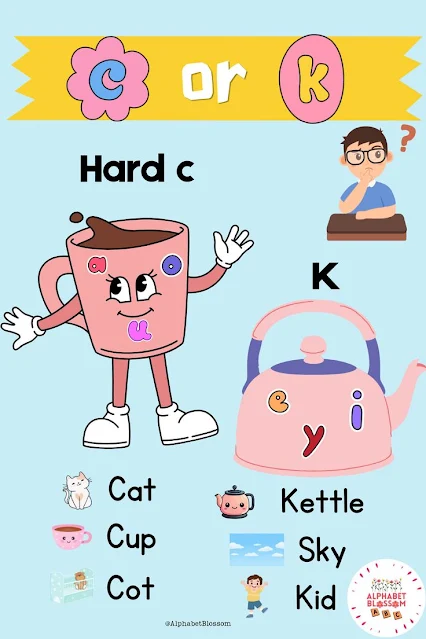Introduction
One of the exciting steps in phonics instruction is teaching children the difference between the hard "c" and the letter "k". These two letters often make the same sound /k/, but their usage depends on the vowels that follow them. In this article, we’ll explore how to introduce these tricky sounds in a fun and visual way, using helpful characters, clear examples, and engaging visuals.
Understanding the Hard 'C' Sound
The hard "c" makes the /k/ sound, and it's usually used when followed by the vowels a, o, or u.
To help children remember this, we can use a hot chocolate mug character, as shown in the visual. This character is decorated with the vowels a, o, and u, reminding students that these vowels are friendly with the letter "c".
Examples of Hard 'C':
Cat – begins with ‘c’ followed by ‘a’
Cup – begins with ‘c’ followed by ‘u’
Cot – begins with ‘c’ followed by ‘o’
Introducing the Letter 'K'
The letter "k" is used to make the /k/ sound before the vowels e, i, and sometimes y.
To make this memorable, we use a kettle character that carries the vowels e, i, and y—reminding learners that "k" comes before these vowels.
Examples of Words Starting with 'K':
Kettle – begins with ‘k’ followed by ‘e’
Kid – begins with ‘k’ followed by ‘i’
Sky – ends with ‘k’ sound spelled as ‘k’ before ‘y’
Activity Tip for Teachers and Parents:
Let your students sort picture cards into two baskets: one labeled Hard C and the other K. Use visual aids like the mug and kettle characters to make learning multisensory and enjoyable.
Why This Rule Matters
Understanding when to use "c" or "k" helps children with spelling and reading fluency. By reinforcing this rule with visual memory aids, children begin to grasp spelling patterns naturally and confidently.
Conclusion
By using friendly visuals, character stories, and fun sorting activities, teaching the hard 'c' and 'k' sounds becomes both effective and enjoyable. With consistent practice, young learners can master this phonics rule and take a big step toward confident reading and spelling.

Comments